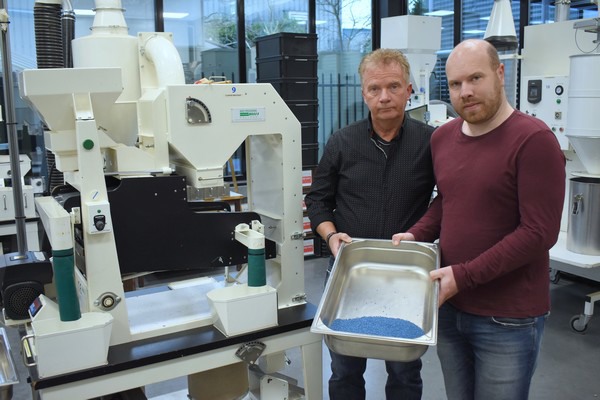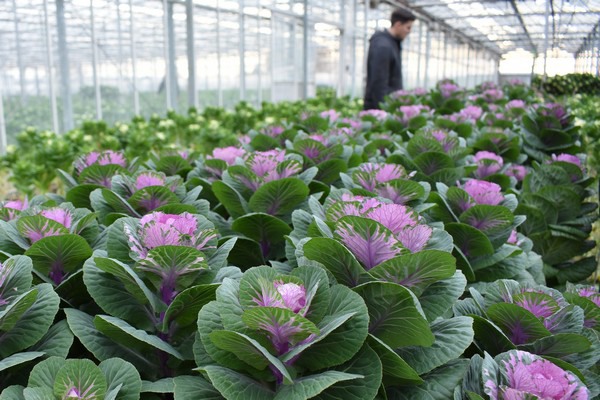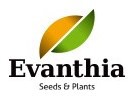Each seed is unique and, as a grower to be able to deliver a uniform product, good sorting is paramount. At Evanthia, not a single seed leaves without being cleaned, tested, weighed by seed size, fractionated and, if desired, treated with an antifungal coating. Seed Technology Manager Mark van der Lugt and Product & Account Manager Leo Boers took us along the journey of a seed, a Brassica seed to be precise, from delivery to the greenhouse of grower Pieter Staalduinen, who then turns it into a beautiful end product!

Leo Boers and Mark van der Lugt
From A to Z
Mark, who after a decade of working with vegetable seeds, switched to flower seeds, tells. “As soon as the seeds arrive, a sample is taken from each batch. These are sown and the germination percentage is noted. Next, there is ‘fractionation’, that is, the smallest size seed is filtered out and the good seed is divided into different fractions."
Via ‘wind cleaning’ and the ‘cloth machine’ the good fractions are upgraded on shape and weight. This way you get uniform batches and you have a product that the grower can work with. Next a germination test is done again and only then a batch is given a sort of official estimate of the percentage of good seed. “Germinate, say 93%, but if on average only 86% appears to germinate in a plant, then the cause of this will be looked into. If the germ ultimately does not meet the set standard, this will be compensated.
In many cases, customers choose whether or not they want a coating on the seed. With Brassicas, a color coating is only used to make it visible during sowing. The seeds are so small that you do not immediately see whether you have sown one, three or none. With a color coating that is more evident, you sow more evenly and you get a more uniform crop as a result.
New species
At Evanthia, as a breeder, developing new varieties is the core business. "In recent years we have developed quite a nice assortment of our own Brassicas", continues Leo, in practice often the link between breeding, sales and the grower. “The breeder does what he is good at, but he must be directed with what the grower and the trade would like to see. At the same time, the grower has their own requirements and cultivation questions, which you naturally also listen to. That is why the aim is not to deliver a batch of seeds, but to deliver a great end product together with all parties.
However, you can never give a full guarantee, because it is a natural product, but also because you could always have done more testing. “One test is not enough, circumstances always change. That is why you go further into the chain, towards the grower, and do practical tests there. And below the line always applies: honesty is the best policy. If something turns out not to work, then potential customers should be made aware of seed types from the competition that are objectively better for their cultivation."
Pieter in the greenhouse among different trials
Cultivation
One of the growers that has been doing business with Evanthia is Pieter van Staalduinen. Since three years ago he has been growing Brassicas on 7000 meters, in his own words mainly because it fits well in his schedule. In spring and summer he is growing, among other things, Carthamus (cut flower type), the greenhouse is empty from mid-July and after cleaning there is half a year room for something else. Additionally, you grow Brassica cold and if necessary you can use heating to stay frost-free.
Is growing Brassica difficult? Not really, Pieter says, but you need to have a bit of luck with it. “You should already have a few good cold nights in the fall, because only then will they will get color. Two years ago they only got color in January and that is too late. Then the season is more or less over. The following year was already a lot better and the season that just ended was excellent.”
He has only cultivated rounded-leave white. Approximately 80% of these are destined for Christmas arrangements and are often painted and glittered. But this year he did some tests together with Evanthia. It concerns a win-win situation: Evanthia, which is also based in the Westland, is compiling a reference, and for Pieter, he feels it is worth it to expand his assortment. "I recently bought a greenhouse, the market is good and I think maybe I will add a section of red next year."
Next week you can visit the Evanthia booth in Hall 2.E.33 during IPM Essen. Among the range of Evanthia's genetics and tropical (young) plants from seed and tissue culture, the Brassica Empire series will certainly not be absent.
For more information:
Evanthia
Vlotlaan 560
2681 TX Monster
The Netherlands
T: +31 (0)174 715103
E: sales@evanthia.nl
www.evanthia.nl
Pieter Staalduinen
E: pieter@staalplant.nl
